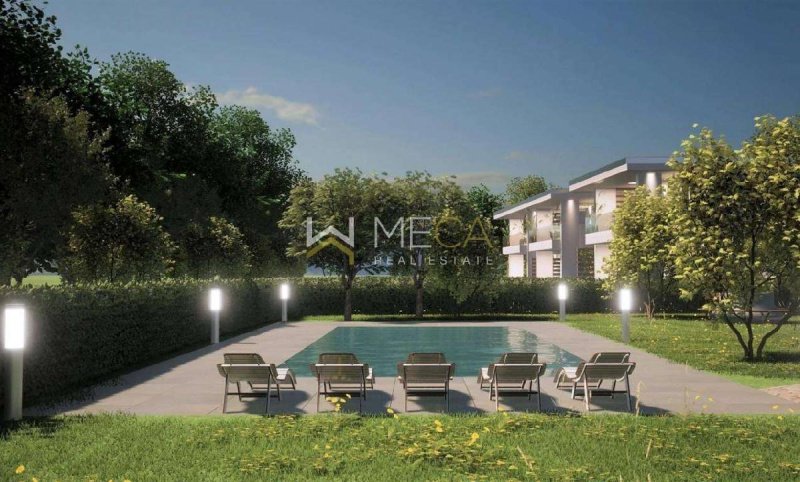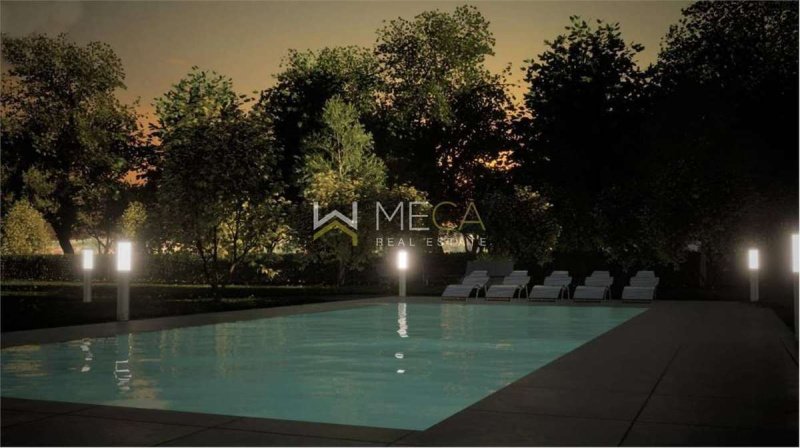Manerba del Garda, new three-room apartment on the first and last floor, swimming pool and exclusive covered parking spaces, delivery scheduled for June 2025, also available apartments on the ground floor with private garden.
The apartment is part of a small complex consisting of only 5 other real estate units, excellent exposure and brightness of the internal environments, 1,400 square meters of common greenery and 60 square meter infinity pool.
Very convenient location for all services, within walking distance and 2 kilometers away from the Romantica beach.
Contemporary technology, photovoltaic system, no gas, heat pump, underfloor heating, triple glazed windows, mosquito nets, controlled mechanical ventilation and other features.
The three-room apartment consists of a living area with open kitchen and access to a spacious covered terrace of 23 square meters; bathroom, two double bedrooms, one with private bathroom, both bedrooms have access to their respective balconies.
The apartment is sold complete with cellar, two covered parking spaces and an uncovered parking space, all of which are exclusive property.
Maximum energy class.
Monuments and places of interest
San Sivino-Gabbiano pile-dwelling site, included in the UNESCO World Heritage List, as part of the transnational serial site Prehistoric pile-dwelling sites around the Alps. History Legend has it that Manerba was built in devotion to the goddess Minerva. She came to hide in this valley, an important and suggestive center of Valtenesi, where she planted her olive trees (of which she was the protector) and taught many of her arts. A temple was built in her honor, but it was destroyed by the Barbarians.' Many scholars believe that the toponym of Manerba derives from "Minerva arx". Others instead trace the name back to the Cenomani Gauls (the term derives from the union of "mon", meaning man of arms, and "erb", military area). The toponym would indicate, in this case, "a fortified place, residence of the chief": this is plausible given that from the top of the Rocca of the town it was easy to defend oneself from any attack. The presence of man on Lake Garda dates back to prehistory, more precisely to the Late Neolithic (about 4000 BC): under the Rocca, in fact, remains of a Mesolithic village have been found. Since the Lombard era, the area was part of the court of the Monastery of San Colombano of the Priory of Bardolino and of the priory of Solarolo, dependent on the Abbey of San Colombano of Bobbio (PC) and of the large monastic fiefdom of Bobbio. The monks evangelized the territory, encouraging the expansion of trade, agriculture (especially vines and olives), the fishing system, and culture, introducing important innovations and opening trade routes. The presence of man on Lake Garda dates back to prehistory, more precisely to the Late Neolithic (about 4000 BC): under the Rocca, in fact, remains of a Mesolithic village have been found. Since the Lombard era, the area was part of the court of the Monastery of San Colombano of the Priory of Bardolino and the priory of Solarolo.
自动翻译所用的语言
Manerba del Garda, nuovo trilocale posto al primo e ultimo piano, piscina e posti auto esclusivi coperti, consegna prevista per Giugno 2025, disponibili anche appartamenti al piano terra con giardino privato.
L'appartamento fa parte di un piccolo contesto composto da altre sole 5 unità immobiliari, ottima esposizione e luminosità degli ambienti interni,1.400 mq di verde comune e piscina a sfioro di 60 mq.
Posizione comodissima a tutti i servizi, raggiungibili a piedi ed a 2 kilometri di distanza dalla spiaggia Romantica.
Tecnologia contemporanea, impianto fotovoltaico, no gas, pompa di calore, riscaldamento a pavimento, infissi a triplo vetro, zanzariere, ventilazione meccanica controllata ed altri accorgimenti.
Il trilocale è composto da zona giorno con cucina a vista e accesso a spaziosa terrazza abitabile coperta di 23 mq; bagno, due camere matrimoniali di cui una con bagno privato, entrambe le camere hanno acceso sui rispettivi balconi.
L'appartamento è venduto completo di cantina, due posit auto coperti e un posto auto scoperto, il tutto di proprietà esclusiva.
Massima classe energetica.
Monumenti e luoghi d'interesse
Sito palafitticolo San Sivino-Gabbiano, inserito nella lista del Patrimonio dell'Umanità dell'UNESCO, nell'ambito del sito seriale transnazionale Siti palafitticoli preistorici attorno alle Alpi. Storia La leggenda narra che Manerba fu eretta in devozione alla dea Minerva. Ella venne a nascondersi in questa valle, importante e suggestivo centro della Valtenesi, dove piantó i suoi ulivi (dei quali era la protettrice) e insegnó molte delle sue arti. In suo onore fu costituito un tempio che peró venne distrutto dai Barbari.' Molti studiosi credono che il toponimo di Manerba derivi da "Minerva arx". Altri invece fanno risalire tale nome ai galli cenomani (il termine deriverebbe dall'unione di "mon", che significa uomo d'armi, ed "erb", zona militare). Il toponimo indicherebbe, in questo caso, "un luogo fortificato residenza del capo": ció è plausibile dato che dall'alto della Rocca del paese risultava agevole difendersi da qualunque attacco. La presenza dell'uomo sul Lago di Garda risale alla Preistoria, più precisamente al Tardo Neolitico (circa 4000 a.C.): sotto la Rocca, infatti, sono stati ritrovati resti di un villaggio del Mesolitico. La zona faceva parte fin dall'epoca longobarda della corte del Monastero di San Colombano del Priorato di Bardolino e della prioria di Solarolo, dipendente dall'Abbazia di San Colombano di Bobbio (PC) e del grande feudo monastico di Bobbio. I monaci evangelizzarono il territorio favorendo l'espansione dei commerci, dell'agricoltura (specie la vite e l'olivo), del sistema di pesca, e della cultura, introducendo importanti innovazioni ed aprendo vie commerciali. La presenza dell'uomo sul Lago di Garda risale alla Preistoria, più precisamente al Tardo Neolitico (circa 4000 a.C.): sotto la Rocca, infatti, sono stati ritrovati resti di un villaggio del Mesolitico. La zona faceva parte fin dall'epoca longobarda della corte del Monastero di San Colombano del Priorato di Bardolino e della prioria di Solarolo.
CLASSE ENERGETICA:
Manerba del Garda, neue Dreizimmerwohnung im ersten und letzten Stock, Swimmingpool und exklusive überdachte Parkplätze, Fertigstellung geplant für Juni 2025, auch Erdgeschosswohnungen mit privatem Garten verfügbar.
Die Wohnung ist Teil eines kleinen Komplexes mit nur 5 weiteren Immobilieneinheiten, hervorragender Belichtung und Helligkeit der Innenräume, 1.400 qm gemeinsamer Grünfläche und einem 60 qm großen Infinity-Pool.
Sehr günstige Lage für alle Dienstleistungen, zu Fuß erreichbar und 2 Kilometer vom Strand Romantica entfernt.
Zeitgemäße Technik, Photovoltaikanlage, kein Gas, Wärmepumpe, Fußbodenheizung, 3-fach verglaste Fenster, Moskitonetze, kontrollierte Wohnraumlüftung und weitere Ausstattungsmerkmale.
Die Dreizimmerwohnung besteht aus einem Wohnbereich mit offener Küche und Zugang zu einer großzügigen überdachten Terrasse von 23 m2; Badezimmer, zwei Doppelschlafzimmer, eines mit eigenem Badezimmer, beide Schlafzimmer haben Zugang zu ihren jeweiligen Balkonen.
Die Wohnung wird komplett mit Keller, zwei überdachten Parkplätzen und einem nicht überdachten Parkplatz verkauft, alles im Alleineigentum.
Höchste Energieklasse.
Denkmäler und Sehenswürdigkeiten
Pfahlbaustätte San Sivino-Gabbiano, eingetragen in die UNESCO-Welterbeliste, innerhalb der transnationalen seriellen Stätte Prähistorische Pfahlbaustätten rund um die Alpen. Geschichte Der Legende nach wurde Manerba zu Ehren der Göttin Minerva erbaut. Sie versteckte sich in diesem Tal, einem wichtigen und eindrucksvollen Zentrum des Valtenesi, wo sie ihre Olivenbäume pflanzte (deren Beschützerin sie war) und viele ihrer Künste lehrte. Ihm zu Ehren wurde ein Tempel errichtet, der jedoch von den Barbaren zerstört wurde. Viele Wissenschaftler glauben, dass der Ortsname Manerba von „Minerva arx“ abstammt. Andere führen den Namen hingegen auf die Cenoman-Gallier zurück (der Begriff leitet sich aus der Verbindung von „mon“, was Waffenmann bedeutet, und „erb“, Militärgebiet, ab). Der Ortsname würde in diesem Fall auf „einen befestigten Ort, an dem der Häuptling residierte“ hinweisen: Dies ist plausibel, da die Stadt von der Festung aus leicht gegen Angriffe verteidigt werden konnte. Die Anwesenheit des Menschen am Gardasee reicht bis in die Vorgeschichte zurück, genauer gesagt bis in die Jungsteinzeit (um 4000 v. Chr.): Unter der Rocca wurden tatsächlich Überreste eines mesolithischen Dorfes gefunden. Seit der langobardischen Epoche war das Gebiet Teil des Hofes des Klosters San Colombano des Priorats Bardolino und des Priorats Solarolo und unterstand der Abtei San Colombano von Bobbio (PC) und dem großen Klosterlehen von Bobbio. Die Mönche missionierten das Gebiet, förderten den Ausbau des Handels, der Landwirtschaft (vor allem des Wein- und Olivenanbaus), der Fischerei und der Kultur, führten wichtige Neuerungen ein und eröffneten Handelsrouten. Die Anwesenheit des Menschen am Gardasee reicht bis in die Vorgeschichte zurück, genauer gesagt bis in die Jungsteinzeit (um 4000 v. Chr.): Unter der Rocca wurden tatsächlich Überreste eines mesolithischen Dorfes gefunden. Seit der langobardischen Epoche war das Gebiet Teil des Hofes des Klosters San Colombano des Priorats Bardolino und des Priorats Solarolo.


